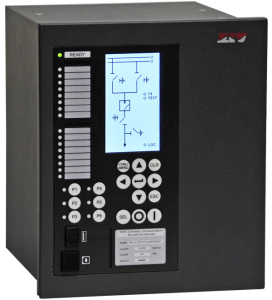Line Differential Protection Relay with Distance Backup. Both functions are suitable for lines of any Voltage Level, Overhead or Under Ground, Multiterminal, and Single or Parallel Circuits
The DLF includes all the protection, control and measurement functions for a power line with or without Series Compensation, Single Breaker, and Single or Three Pole Tripping.
The fast Differential Unit, complemented by the External Fault Detector and the Capacitive Current Compensation unit, protects lines with up to 3 terminals, even with a transformer in the protection zone, providing excellent reliability even in the most adverse conditions. Breaker and a Half or Double Busbar (with CT group on the line) configuration capability added in DLF-B.
DLF IEDs combine the Differential protection units with Distance protection elements (and complementary units such as Close-onto-Fault, Dead-Line, Remote Breaker Open, VT Fuse Failure, Power Swing and Load Encroachment detectors), Over / Undervoltage and Over / Underfrequency protection, Recloser, Synchronism Supervision, Control and Metering functions.
Line Differential Protection Relay Key Features:
- Phase Differential Unit: Configurable with 3 three-phase current inputs, to protect up to 3-terminal lines.
- Neutral, Negative Sequence and Positive Sequence Differential Units :Increases sensitivity during internal faults with low current contribution, such as very resistive faults, which may not be detected by the differential phase unit.
- External Fault Detector:Blocks the differential unit against external faults with very high CT saturation, providing exceptional security.
- Capacitive Current Compensation: The differential unit maintains good sensitivity in cables and very long overhead lines.
- Transformer-Line Protection Zone
- Multi-End Fault Locator
- 8 Distance Zones: Reversible distance zones with Mho or quadrilateral characteristic. Independent characteristic selection for ground and phase-to-phase faults.
- Communication between IEDs
- 2 ports: Communication without redundancy with up to 2 remote ends or with redundancy with one remote end.
- Selectable speed: from 1..12 x 64 kbit/s (C37.94) and 2 Mbit/s.
- Multimode or single mode FO interfaces (optional SFPs).
- Communication with SDH multiplexers via C37.94 or via ZIV model F2MUX optical-electric converter that integrates G703 output interfaces.
- Up to 16 digital signals can be exchanged between terminals to implement teleprotection schemes.
General characteristics of the “ZIV e-NET flex family” protection relays:
- Powerful programable logic. 9 2000 event log. Up to 100 oscillography seconds.
- Alphanumeric or graphic display.
- 10 analog channels (12 in DLF-B models), 160 DI, 80 DO, and 22 LEDs.
- Bonding, RSTP, PRP and HSR Redundancy.
- IEC 61850 Ed.2, DNP3.0, Modbus RTU and PROCOME Protocols.
- Native process bus. Analog input cards operate as Merging Units for the CPU. Synchronized samples at 4800 Hz (as per IEC 61869-9).
- Cybersecurity in accordance with IEC 62351, IEC 62443 and IEEE 1686-2013 standards. RBAC, secure keys, physical and logical port disabling, cybersecurity event log, securing of management protocols (PROCOME, HTTPS, SFTP, SSH), remote authentication (LDAP, RADIUS) and digital firmware securitization.
- Time synchronization by IRIG-B, SNTP and PTP (Ordinary Clock / Transparent Clock).
Literature
- Instructions Manual: M0DLFA1907Iv42 (10/2025)
- Data Sheet: H0DLFA1807Iv05 (EN) H0DLFA2203Pv01 (P) H0DLFA2203Fv01 (FR) - rev 03.2024


